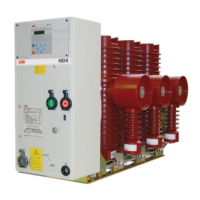31
Carry out the following operations before putting the circuit-
breaker into service:
– make sure that the power connections to the circuit-break-
er terminals are tight;
– establish the setting of the primary electronic overcurrent
release (if provided);
– make sure that the value of the power supply voltage of the
auxiliary circuits is between 85% and 110% of the rated
voltage of the electrical applications;
– makesurethattherearenoforeignbodies,suchasbitsof
packing,inthemovingparts;
– toavoidovertemperatures,makesurethatthereisa suf-
ficient exchange of air in the place of installation;
– also perform the inspections indicated in the following ta-
ble:
8. Putting into service
All the operations for putting into service
must be carried out by ABB personnel or by
the customer’s qualified personnel.
If the operations are obstructed in any way,
do not force the mechanical interlocks and
check that the operating sequence is correct.
The operating forces which can be applied
are indicated in paragraph 6.3.
Discharge the closing springs (close and
open the circuit-breaker) to access the inside
of the operating mechanism.
Disconnect the PR521 release (if provided)
before conducting insulation tests on the
circuit-breaker.
8.1 General procedures
Subject of the inspection Procedure Positive check
1
Insulation resistance.
Medium voltage circuit
Usinga2500VMegger,measuretheinsulation
resistance between the phases and between
phases and earth the circuit.
The insulation resistance should be at least 50 MΩ
and must remain constant over time.
Auxiliary circuits
Usinga500VMegger(installedequipment
permitting),measuretheinsulationresistance
between the auxiliary circuits and the earth.
The insulation resistance should be several MΩ and
must remain constant over time.
2
Auxiliary circuits. Make sure that the connections to the control
circuit are correct: proceed with the relative power
supply.
Normal operations and signals.
3
Manual operating mechanism. Perform a few closing and opening operations (see
chap. 6).
NOTE. Power the undervoltage release and the
locking magnet on the operating mechanism at the
relative rated voltage (if provided).
The operations and relative signals occur correctly.
4
Motor operator (if provided) Power the spring loading gearmotor at the relative
rated voltage.
The springs are loaded correctly.
The signals are correct.
The gearmotor stops when the springs have been
loaded.
Perform a few closing and opening operations.
NOTE. Power the undervoltage release and the
locking magnet on the operating mechanism at the
relative rated voltage (if provided).
The gearmotor reloads the springs after each
closing operation.
5
Undervoltage release (if provided). Power the undervoltage release at the relative rated
voltage and perform the circuit-breaker closing
operation.
The circuit-breaker closes correctly.
The signals are correct.
Disconnect the power supply to the release. The circuit-breaker opens.
The signal changes over.
6
Opening release. Close the circuit-breaker.
Power the shunt opening release at the relative
rated voltage.
The circuit-breaker opens correctly.
The signals are correct.
7
Shunt closing release (if provided). Open the circuit-breaker. Power the shunt closing
release at the relative rated voltage.
The circuit-breaker closes correctly.
The signals are correct.
8
Key lock. Open the circuit-breaker.
Turn the key and remove it.
Attempt the circuit-breaker closing operation.
Neither manual nor electric closing takes place.
Insert the key again and turn it through 90°.
Perform the closing operation.
Both electric and manual closing take place
correctly; in this position the key cannot be
removed.
9
Auxiliary contacts in the operating
mechanism
Insert the auxiliary contacts into suitable signalling
circuits.
Perform a few closing and opening operations.
The signals occur correctly.

